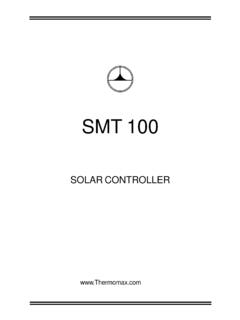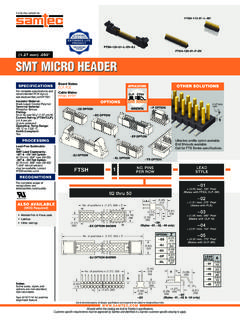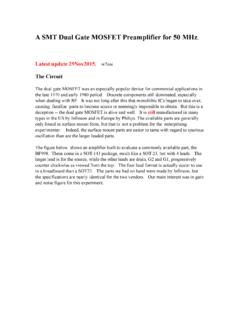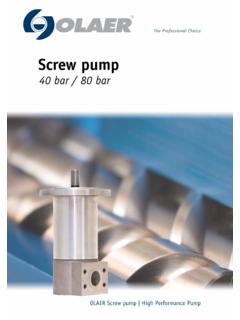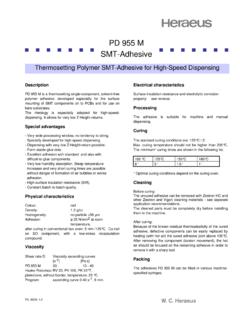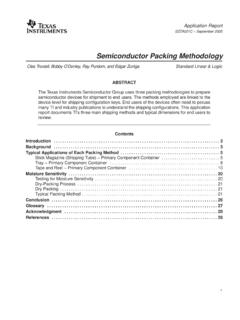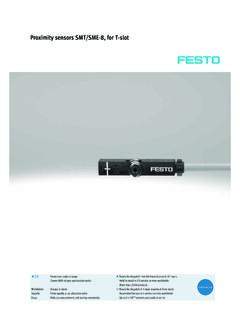Transcription of TI OMAP4430 POP SMT Design Guideline (Rev. C)
1 1TI OMAP4xxx POP SMT Design Guideline We SupportMichael Chen (TITL PKG)Kenji Masumoto (HIJI PKG)Shawn Wu (TITL PKG)Kurt Wachtler (WTBU PKG)2 Index:XPackage IntroductionXOMAP4 SMT Process sharingXAppendix9 Stencil/PCB Design guide9 Memory chip flux/solder dipping in 1-step mounting9 The example of Pick & Place machine condition setting9 Reflow profile recommendation9 SMT experiment examples9 Through molded via solder rework methods9X-ray examples9 Screen print material and tool examples9 Package warpage affect examples3 OMAP4 XXX POP PackagesMemoryOMAP 4 System Board4 OMAP4xxxMechanical Drawing of OMAP4xxx CBS (TMV)Top ViewBottom View5 OMAP4xxx TMVD2A-DimensionD36 Memory ChipMechanical Drawing of Memory ChipBottom View7 Agenda:XPackage IntroductionXOMAP4 SMT Process sharingXQ& A9 Stencil/PCB Design guide9 Memory chip flux/solder dipping in 1-step mounting9 The example of Pick & Place machine condition setting9 Reflow profile recommendation9 SMT experiment examples8 PWB Land & Stencil aperture Design Recommendation for pitch Mask DefinedNSMDABNon Solder Mask DefinedStencil/PCB Design guide for OMAP4 ABThicknessOpeningStencil DesignBall PitchPWB Design Avoid VIP( Via in Pad) Design .
2 If should do it, the plugged via with flatten surface is recommended. SMD Design is more suggested than NSMD to prevent the solder starvation form trace neck or irregular joint shape. Trace Design : No big ground with several pads connection or wide trace neck. Square opening of Stencil can get more volume for joint print. * (Zone C)(Zone A+B) (Zone C)(Zone A+B) on Package (POP)Surface Mount Assembly Process Flow Screen print solder paste to PCB Pick and place OMAP BGA PCB Reflow to form POP stackPCB Dip Memory package into flux or paste Place on top of OMAP packageFlux Dip StationMemoryOMAPOMAPM emory10 Flux/solder past dip depth:From the evaluation, the optimal results at 50-70 % flux dip and solder paste. Variable depth of fluxBall 20% 50% dipping A memory DC package, is dipped into flux with variable depth50%66%50% is appropriate dipping depthBall height50% depthMemory chip flux/solder dipping recommendation in 1-step mounting Memory Chip11 Memory Paste dipping & SMTM achine Control SettingMemory ChipBall heightDip depthPaste heightBalance the in/out transfer speed & dwell time to get optimized solder Dip too fast + paste suppress by 4 balls and extrude the additional paste up & attached on the bottom of substrate surface.
3 12 Flux/Solder Paste Depth MeasurementFlux/paste dipping depth was measured by using height gauge shown in below of height measurementFlux/Paste Dipping feederGood dip sampleBad dip sampleFlux or PasteRoll & measureThe dipping performance contributed the top level soldering yield of flux depth (Example)14 Panasonic NPMNext Production ModularNozzle type: 1004 Placement Parameters: Condition of PnP M/C setting(example)9 SMT M/C Brand: Panasonic9 Type: NPM9 Device Placement: OMAP4 + Memory Chip9 Placement method: By 1-step9 Fiducial marks recognition for placement: By Board fiducial9 Pick up Nozzle type: 10049 Nozzle size: ~8mm (with robber tip)9 Memory Vision sequence:Pickup + Camera vision + Memory Dipping + Placement9 Dwell time of memory dipping:400ms ~1 sec9 Placement Force (N) or placement depth (um): For OMAP4: package height+1~ (push down)For Memory Chip: package height+1~ (push down)15 Memory PackageFlux Dipping ReservoirSurface Mounter: Fuji NXTI deal Flux Depth = 50-60%Bottom and Top BGA Placement169 Evaluated solder paste: 9 Shenmao PF-606-P (SAC305)9 Tamura TLF-204-19A9 Evaluated Memory dip flux/paste.
4 9 Senju (Paste)9 Senju Deltalux-901K3 (Flux) 9<700 ppm O2 reflow atmosphere is recommended to provide the widest process real profile must be fine-tuned for each product to meet the optimized soldering results RT to 150 C 1~3 C/s Pre heat temp(150~200 C) 60~120sec Time above melting 220 C 50~80sec Peak temp 240-250 C Cool down rate 2~6 C/sec (max.)Reflow conditions:Preheating StageReflowCool Down25020015010050 Temperature Degrees CTimeProfile Recommendation for OMAP4xxx (TMV)17 PCB panel18123 POP profile test board couple test locations: see above picture-Thermal couple test points: a. The central point btw PCB & OMAP b.
5 The central point btw OMAP & Memory -Total 6 test points 192-pass reflow: Pre-stack tray for FCPOPTo check temperature profilePre-stack tray designed for TI OMAP3430 Pre-stack tray designed for TI OMAP3430 Bottom POP is supported bythis rib to depopulated ball area20 Agenda:XPackage IntroductionXOMAP4 SMT Process sharingXQ& A9 Stencil/PCB Design guide9 Memory chip flux/solder dipping in 1-step mounting9 The example of Pick & Place machine condition setting9 Reflow profile recommendation9 SMT experiment examples21 OMAP4xxx SMT Evaluation Preliminary experiments performed concurrent to package Design and material selectionSummary: Nitrogen atmosphere better than air Senju 901K3 better in air than Senju 529D-1* Dipping depth too deep**reference follow up tests in this report22 OMAP4xxx DOE Experiments23 OMAP4xxx DC (TMV) SMT EvaluationDOE124 Flux DippingPaste DippingOMAP4 PackageOMAP4 CBS Daisy ChainOMAP4 CBS Daisy ChainMemory PackageMock UpMock UpSMT BoardNSMD PadsSMD PadsBottom BGA PasteShenmao PF-606-P (SAC305)Shenmao PF-606-P (SAC305)Top BGA Flux or PasteSenju D eltalux-901K3(No-Clean dipping flux)Senju (SAC305, No-Clean dipping paste)Solder StencilLaser and electro-polishedLaser and electro-polishedThickness (um)8080 ShapeRoundRoundOuter Four RowsDiameter (um)250250 Inner RowsDiameter (um)200200 Memory PackageDipping Depth (um)
6 120 - 140umSee other tableReflow ProfilePre-heat time70-80 sec70-80 secTime above Liquid65 - 75 sec65 - 75 secPeak temp and time245-250oC245-250oCReflow AtmosphereNitrogen (700 O2 ppm)Nitrogen (700 O2 ppm)Sample Size540 packages270 YieldOpens (DC net test)0/540 See other tableShorts (X-Ray)0/540 See other tableDOE1 Set Up25 Run 1 Run 2 Flux DippingPaste DippingMemory Ball Height190um190umTop BGA Flux or PasteSenju Deltalux-901K3 (No-Clean dipping flux)Senju (SAC305, No-Clean dipping paste)Warm up time> 8 hoursSee below tableMemory Package Dipping Depth (um)120 - 140umSee below tableSample Size540 ea270eaYieldOpens (DC net test)0/540 See below tableShorts (X-Ray)0/540 See below tableDOE1 Results26 Top BGA Typical Solder Joint DefectsDefect: Random single or double non-wet solder jointsRoot Causes: Insufficient flux OMAP and/or Memory solder ball height and gap variation during the reflow processSolution: Flux volume transfer control27 SMT SuccessCustomerBoardReflow ProcessPick & Place PackageAtmosphere.
7 Air or N2 Paste & Flux% MetalThixotropy/ ViscosityPasteSlumpSolder AlloyFluxActivationShelf/ Working LifeSolder StencilMaterialMfg MethodSurface finishOpeningSizeThicknessOpeningshapePr int SpeedSqueegeepressureSnap offSeparationSpeedWarpagePad DesignBGA PitchWarpageThermal LoadBd & PanelDesignPkg SizeAccuracyDwell TimeTemperature Profile & UniformityPOP SMT Process VariablesMemory Dip Flux/Paste Volume TransferTMV SizeSolderAlloySolder Ball SizeSolderParticle SizePressureMold Cap ThicknessMemory PkgBOMS older Paste and Flux Application TI Controlled Standard POP Variables POP-TMV Variables28 OMAP4xxx DC (TMV) SMT EvaluationDOE229 DOE2 Set up: Screen Print Stencil Design & Reflow ProcessOption 1 Option 2 Option 3 Preheat ZoneTemperatureR/T-120C R/T-120C R/T-120 CTime7090110 Soak ZoneTemperature120-180c 120-180c 120-180cTime90110130 Reflow ZonePeak Temperature235240-245245-250 Time above Liquid6080100 Cooling Zone3o/sec3o/sec3o/secReflow Profiles30 DOE2: Solder Pasteand FluxSolder paste for memory dipping:Senju for memory dipping:Senju DELTALUX 901K3 Solder paste for POP mount:Tamura TLF-204-19A31 DOE2 Results32130um ( actual depth)140um ( actual depth)Black ring is flux wetting bottom of memory package: pulled flux off solder ballFlux transfer to memory package is critical.
8 Type of flux Viscosity of flux Dipping depth Dwell time of package in flux trayFlux viscosity with continuous stirringMemory Dipping Defect Example33140um ( actual depth)105um ( actual depth)180um ( actual depth)Paste Dipping Experiment Result34 DOE2 ResultSummary: Bottom BGA yield robust vs. stencil Design Top BGA yield sensitive to flux dipping process Depth Viscosity Dwell time Top BGA dipping in paste successful: verification required Nitrogen atmosphere (<700ppm O2) required in this test Experiments will continue to define assembly capability in an Air reflow atmosphere35 OMAP4xxx DC (TMV) SMT EvaluationDOE336 DOE3 Set up:ShapeRound 80 VariableSurface FinishLaser Job nano coatingThickness (um)80 Opening Diameter(um)Zone C250 Zones A & B200100% Volume Transfer RateZones C (um3)3926991 Zone A & B (um3)2513274 Opening RatioZones A & Design37 DOE3: Results38 DOE3 ResultSummary.
9 Flux and Paste chemistry and rheology are critical factors for use in an air reflow atmosphere Time out of refrigeration and time worked in dipping tray affects coating uniformity Dipping time change from 600ms to 900ms improved yield A paste that did not work in air worked in nitrogen reflow atmosphere Bottom BGA process continues to be robust Pre-conditioned parts shifted and yielded zero bottom BGA connections: X-ray of top BGA looked normal but unable to test due to lack of connection through bottom BGA39 XAppendix9A1: Through molded via solder rework methods Brush with flux repair method Manual rework method9A2: X-ray examples 9A3: Screen print material and reflow equipment examples9A4: Package warpage affect examples40 Brush with flux for repair in TMV level (1)-Use cotton swab to apply adequate flux at the side-walls of defective then Check in X-ray (see next slide)& O/S test.
10 12345 SizeFlux type Repair levelOKNG5 Senju 529D-1 TMV 50 Test result (Xray, O/S)Evaluate samples41 Brush with flux for repair in TMV level (2)1212123123 The non-wetting TMV joints show as 3 balls overlapped with bottom BGA ball in X-ray defect TMV joints are re-healed & show as 2 balls overlapped with bottom BGA ball in X-ray Solder JointRepaired Solder Joint42 XAppendix9A1: Through molded via solder rework methods Basic repair method Manual rework methodNote: this method is not recommended for product repair due to the number of times the topside solder ball is reflowed9A2: X-ray examples9A3: Screen print material and reflow equipment examples9A4: Package warpage affect examples43 Check externalClean solderPre bake, Dry N2 Oven, 125degC, 3hrAdd new ball on top side (SAC105 solder alloy, diameter)Dry N2 Oven Bake 240degC 5minAdd new ball on Bottom side (M705 solder alloy, diameter)Finished reballCoat solder paste (SAC305 solder alloy) TOP SIDE Clean sub routineRemove solder by solder cleaner (machine example: Hozan HS-800) Clean by flux remover (material example: HAKKO 017)Bottom SIDE Clean and surface preparation: follow standard BGA methodsManual Rework FlowClean by flux remover (material example: HAKKO 017)Dry N2 Oven Bake 240degC 5minTMV de-solder and re-ball(See the exact process in next slide)Process Flow of Manual TMV Rework (1) TMV Rework Option BNote.










